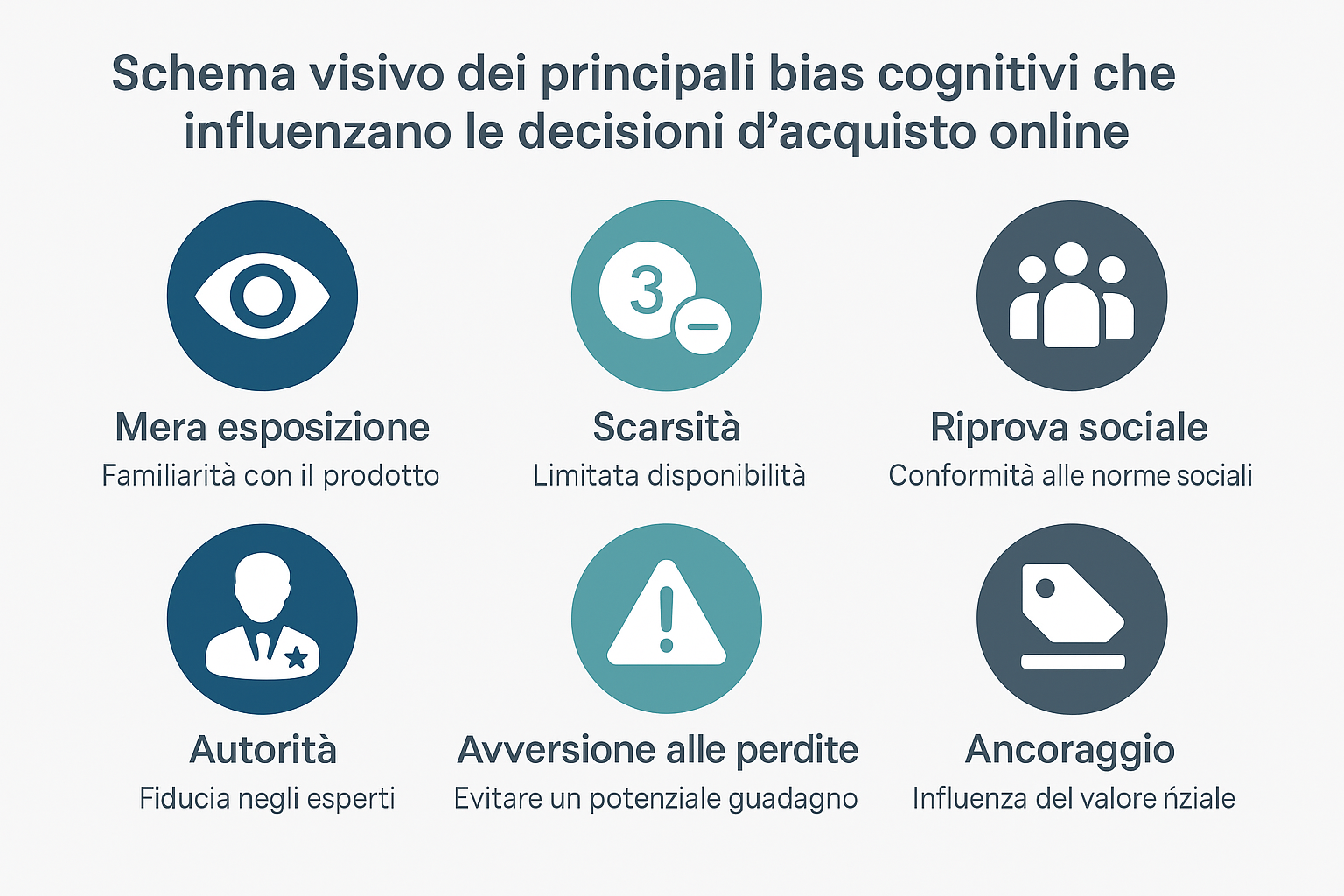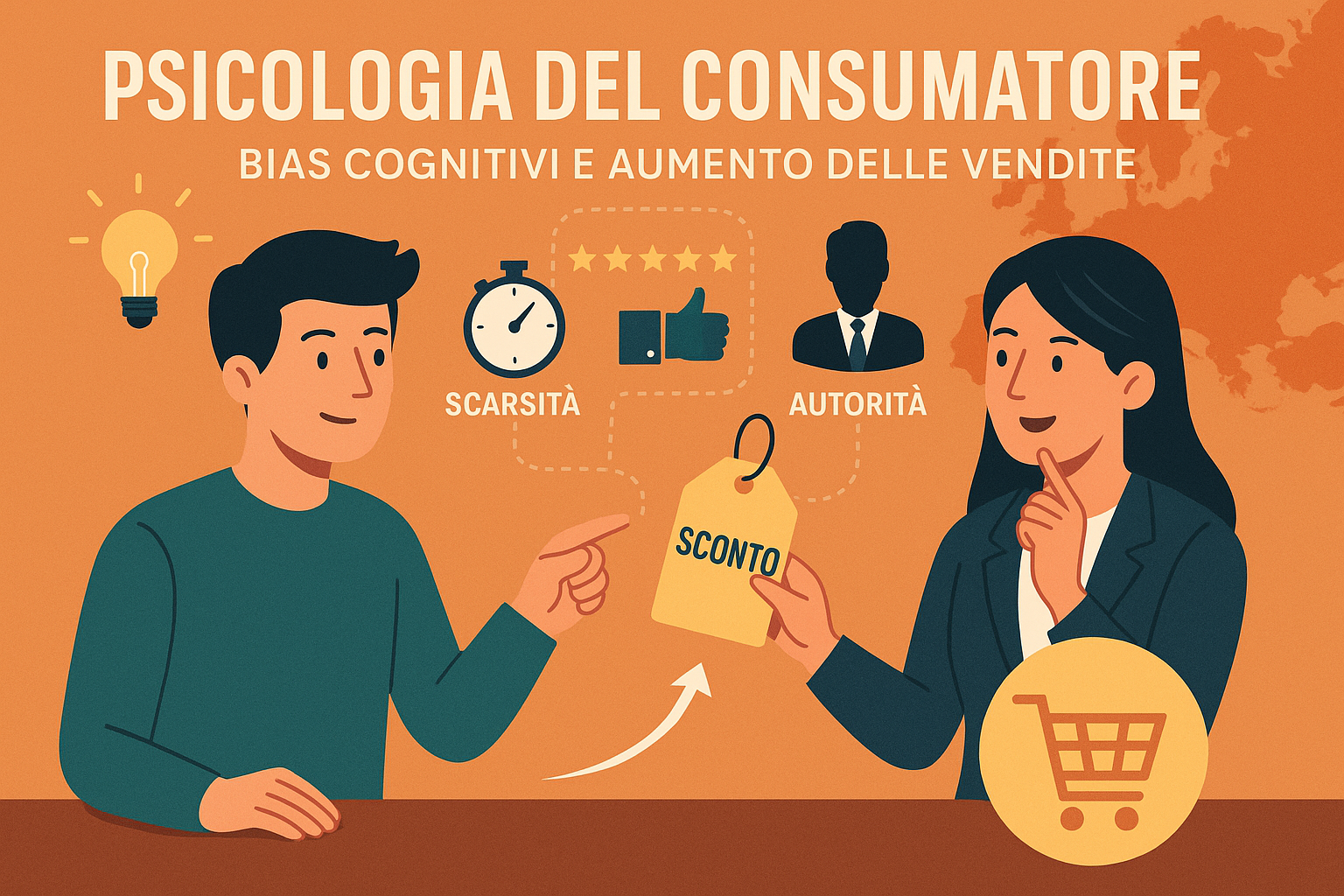Consumer Psychology: Cognitive Biases and Strategies to Increase Sales in Italy and Europe
Understanding why people buy is the secret of every brand that wants to grow. From mere exposure to scarcity, all the way to social proof: cognitive biases explain what logic often cannot. And in digital marketing—especially for those selling online—mastering them means selling more and building stronger loyalty.
TL;DR
People don’t buy only with logic, but with psychology. Cognitive biases influence every purchase decision, from clicking on a marketing banner to the final checkout. Knowing and ethically using these mechanisms helps Italian and European companies increase conversions, trust, and brand value.
Why knowing consumer psychology is a strategic lever
Every day, the human brain makes over 35,000 decisions. Most of them are automatic, based on mental shortcuts—cognitive biases. Understanding them allows marketers to build advertising campaigns, websites, and eCommerce experiences that truly speak to how the customer’s brain works.
For over 25 years, HT&T Consulting has supported Italian and European brands in connecting digital strategy, neuromarketing, and data. Our approach combines behavioral analysis and technical optimization to help B2C and B2B businesses grow. From SEO to design, and from UX to Google and Meta advertising, every project is built to turn psychological insights into measurable results.

1. Mere Exposure Effect: Familiarity that Persuades
The Mere Exposure Effect demonstrates that the more we see something, the more we like it. It’s a fundamental principle of consumer psychology: repetition builds trust, and trust drives purchases.
How to apply it in digital marketing
- Retargeting campaigns: repeatedly showing a brand reinforces familiarity. After 3–4 exposures, click probability increases by up to 70%.
- Continuous content marketing: publishing articles and newsletters keeps the brand “top of mind”. Familiarity becomes authority.
- Local SEO and brand visibility: for a digital agency in Tuscany or a pan-European eCommerce, appearing frequently in local results builds trust. Being found often is better than being found once.
To explore this fundamental marketing concept, we wrote a dedicated in-depth article on the Mere Exposure Effect.

2. Scarcity Principle: The Desire for the Unreachable
The Scarcity Principle is based on the fear of missing out (FOMO). When a product or offer is perceived as rare or time-limited, its perceived value increases exponentially.
How it translates into sales
- Time-limited offers: “Only for 48 hours!” or visual countdowns can increase conversions by up to 30%.
- Real stock limitations: “Only 2 items left!” Beware: fake scarcity violates the EU Omnibus Directive.
- Handcrafted products: in Made in Italy, limited availability is part of the value itself.
Note for the European market: the EU Omnibus Directive requires complete transparency: any urgency or scarcity message must be verifiable.
HT&T Consulting helps brands create ethical urgency levers in their eCommerce, combining persuasive copywriting, UX improvements, and Shopify/Magento 2 automations to maximize conversion rate (CRO). We also published an in-depth article on the Omnibus topic.
3. Social Proof: If Everyone Does It, It Must Be Right
This is the bias that drives millions of users to trust reviews or prefer brands with “more stars”. If many people choose something, the brain concludes it must be the correct choice.
How to use it in marketing
- Reviews and third-party platforms: using platforms and showing positive ratings can boost initial trust by up to 270%. Negative reviews, however, have the opposite effect.
- Testimonials and brand partners: mentioning well-known clients (“Used by Ferrari or Luxottica”) increases perceived safety.
- Dynamic social proof: real pop-ups (“5 people are buying now”) can improve conversions by up to 15%.
Some of the most relevant platforms
- Google Business Profile –
https://www.google.com/business/
(Essential for any local business: shops, restaurants, services) - Trustpilot –
https://www.trustpilot.com/
(Leading platform for online businesses and digital services) - TripAdvisor –
https://www.tripadvisor.com/
(Key platform for hospitality: hotels, restaurants, attractions) - Amazon Reviews –
https://www.amazon.com/
(Indispensable for merchants selling physical products) - Facebook Recommendations –
https://www.facebook.com/
(Very useful for local businesses and service-based companies) - Booking.com –
https://www.booking.com/
(Fundamental for hotels and hospitality) - TheFork –
https://www.thefork.com/
(Crucial platform in Italy for restaurants) - Feedaty –
https://www.feedaty.com/
(Italian service widely used for verified eCommerce reviews) - Reviews Verificate (Skeepers) –
https://skeepers.io/en/
(Popular in Europe for certified eCommerce reviews) - Treatwell –
https://www.treatwell.com/
(Key platform for beauty and wellness services)
In the European market—where consumers are more informed and skeptical—social proof is the currency of trust. HT&T integrates review systems, automations, and reputation management strategies tailored to each brand.
4. Principle of Authority: Trust in Experts
We tend to trust those we perceive as competent. This is the principle of authority: in marketing, it translates into a brand’s ability to appear reliable, certified, and recognized in its sector.
How to apply it
- Certifications and partnerships: badges such as “Google Premier Partner” or “Meta Certified Partner” communicate authority. HT&T holds both, which reassures clients about skills and performance when investing their budget in advertising: relying on people who know the platform deeply, are constantly updated, and are supported by Google and Meta gives security and protects the client by ensuring investments are managed in the best possible way.
- Brand endorsement: displaying client logos or media mentions (“As seen on Il Sole 24 Ore”) creates a powerful reputational effect.
- Expert content: articles like this one, webinars, and whitepapers signed by in-house professionals strengthen trust in the brand.
In the European market, where consumers tend to be more rational and focused on credibility, building authority is key to scaling. While in Italy certifications and awards are often perceived as less central by the general public, in many European countries being officially recognized as authoritative and capable is a crucial value driver.
5. Loss Aversion: the Strongest Psychological Lever in Marketing
Now we enter one of the most fascinating and powerful areas of consumer psychology. If we had to choose a single bias that drives economic behavior more than any other, it would probably be Loss Aversion. This concept describes a simple yet disruptive psychological fact: for our mind, the pain of losing something is about twice as strong as the pleasure of gaining the same thing.
In other words, finding €20 on the street gives you a certain amount of pleasure. But losing €20 that were already in your wallet causes a level of discomfort that is roughly double. Our brain is not a rational accountant; it is an emotional machine designed to protect what it already owns.
What does this have to do with marketing? Everything. It shifts the entire axis of communication. The phrase “Get 20% off” talks about a gain (pleasant, but not urgent). The phrase “Don’t miss your 20% discount” talks about a loss (painful, something to actively avoid). The second formulation frames the discount not as a bonus, but as a status quo that is about to be taken away from you. And this pushes us to act with far more urgency.
Practical applications: how to frame “loss”
Once you understand the principle, its applications in marketing become clear. It’s not about selling a product, but about selling the “non-loss” of a benefit.
The genius of free trials
Why do services like Spotify, Netflix or any SaaS push so hard on “30 days free trial”? It’s not just to let you try the product. It’s to activate a related psychological lever: the Endowment Effect. During those 30 days, you start to feel that service as yours. You integrate ad-free listening, offline playlists, or access to that tool into your daily routine. When the trial period is about to expire, the brain doesn’t interpret it as “Okay, now I decide whether to buy”. It experiences it as “I’m about to lose my music without ads!”. The purchase is no longer a gain, but the only way to avoid the pain of losing something that already felt like it belonged to you.
The ‘trap’ of loyalty programs
Loyalty programs—from supermarket point collections (such as Esselunga’s Fìdaty card or the COOP membership card) to tiered airline schemes (for example Freccia Alata status by Alitalia/ITA or Argento, Oro, Platino and Platino Infinito in Trenitalia’s CartaFRECCIA)—do not work only on the promise of a future reward. They leverage loss aversion. A customer who has collected 800 points doesn’t want to lose the value of those points by no longer shopping there. A “Gold” traveler will do almost anything not to lose their status (and related perks, such as priority boarding) the following year, even if it means choosing a less convenient flight just to stick with the same airline.
Free Shipping (but only above a certain threshold)
This is one of the most brilliant implementations. How many times have you found yourself with a cart of €45 and a message saying “Add €5 more to get free shipping”? Rationally, you could just pay €6 for shipping. But loss aversion is not rational. Paying €6 for shipping is perceived as “throwing money away”, a pure loss. The brain perceives it as much smarter to “invest” another €5 (or more) in an extra product (a gain) in order to avoid the loss represented by shipping costs. The eCommerce thus turns a cost (shipping) into an incentive to increase average order value, leveraging our innate aversion to wasting money.

6. Anchoring Effect: the Power of the First Number
The human mind has a curious trait: in order to make decisions, it desperately needs a starting point. In the absence of complete information, it literally “clings” to the first information it receives. This is the core of the Anchoring Effect: that first number, that first impression, becomes the “anchor” to which the entire subsequent decision-making process remains tied.
Once the anchor has been dropped in the consumer’s mind, every subsequent piece of information is no longer evaluated objectively, but compared to that initial anchor. The brain doesn’t ask, “How much is this product worth?” but rather, “Is this product worth more or less than the first number I saw?”
How to use anchoring to sell more
This cognitive distortion is perhaps the most widely used—whether consciously or not—in any pricing strategy. It’s not just about numbers, but about defining perceived value.
-
Strikethrough prices (the king of anchoring):
The classic example: “List price €199, now €99”. The most important part of that sentence is not “€99”. It’s “€199”. That figure acts as an anchor, fixing the value of the product in the customer’s mind. Without that anchor, “€99” is just a price to be evaluated. After seeing “€199”, however, “€99” is no longer a cost but a saving of €100. The customer feels they are not just buying a product at €99, but gaining €100 in discount. -
Pricing plans (the ‘decoy’ technique):
Why do SaaS products or gyms always display the “Pro” or “Enterprise” plan at €500 first, even if they know most customers will go for the €49 plan? Because €500 is the anchor. Almost no one will buy that plan, but its mere presence makes the “Basic” or “Standard” plan look incredibly convenient and reasonable by comparison. -
Product order (quality anchoring):
Anchoring isn’t just about price. A fine-dining restaurant that shows an €800 bottle of wine at the top of the list doesn’t expect to sell it often. That bottle serves to anchor the perceived quality of the entire wine list, making the €80 bottle that follows look “reasonable”. Similarly, an eCommerce that showcases its premium or flagship products first raises the perceived value of the entire catalog.
As you can imagine, anchoring is a powerful tool that shapes perceived value even before the actual sales conversation begins. In the European context, where regulations such as the Omnibus Directive increasingly enforce transparency (for example, on the actual lowest price used in the last 30 days), this bias cannot be used in deceptive ways.
On the contrary, it must be combined with transparent, value-based pricing strategies. The challenge is not to “invent” a fake anchor, but to communicate the real value of the product first, and in the most effective way. HT&T supports brands exactly here: defining positioning and perceived value through careful data analysis, market benchmarking, and A/B testing, in order to build a solid and successful pricing strategy.
7. Cognitive Dissonance: Reducing Customer Regret
After an important purchase, many customers feel uncertain: “Did I make the right choice?”. This is cognitive dissonance. A smart brand (and the marketing agency behind it) doesn’t ignore it: it prevents it and turns it into post-purchase trust.
How to reduce it
- Empathetic confirmation emails: celebrate the purchase (“Welcome to the HT&T community”) instead of sending a plain receipt.
- Clear post-sale support: providing human, quick responses reduces regret.
- Community and onboarding: offering tutorials, webinars, or dedicated groups reinforces the sense of belonging.
A carefully designed customer experience increases customer lifetime value and reduces churn. That’s why HT&T designs tailored retention strategies for eCommerce and B2B brands—and why we invite you to contact us to explore the topic in more depth.
8. Ethical Marketing and GDPR: Persuading Without Manipulating
Using cognitive biases does not mean manipulating people. In the European context, where regulations such as GDPR and the Omnibus Directive are in force, balance is essential: transparency, respect, and real value for the consumer.
The golden rules of ethical marketing
- Authenticity: scarcity must be real, reviews must be verified, and promises must be kept.
- Informed consent: every personalization or retargeting activity must comply with GDPR.
- Long-term trust: a loyal customer is worth more than a one-off “forced” sale.
We also published a dedicated article on this topic—ethical and sustainable marketing—for those who want to go deeper.
Conclusion: From Psychology to Strategy
Understanding consumer psychology means stopping selling products and starting to deliver experiences. Every cognitive bias—from mere exposure to loss aversion—is a window into the way people decide, act, and build trust.
In the European and Italian markets, where competition and consumer awareness rise every day, companies that understand these mechanisms don’t just sell more—they build stronger relationships based on trust, value, and authenticity.
At HT&T Consulting, we transform over 25 years of experience into measurable digital strategies: SEO, advertising, CRO, UX design, and neuromarketing. From the development of your eCommerce to international growth, our goal is simple: turn human behavior insights into concrete results.
Do you want to improve your conversions and truly understand your customers?
Talk to an HT&T Expert
Explore Our Digital Services
Discover Our Performance Team
FAQ: Frequently Asked Questions About Consumer Psychology
What is consumer psychology?
It is the discipline that studies how emotions, perceptions, and cognitive biases influence purchasing decisions. Understanding it helps brands communicate more effectively and build lasting trust.
What are cognitive biases in marketing?
Cognitive biases are mental shortcuts that guide human behavior. In marketing, they are used to create ethical persuasive levers such as urgency, trust, or authority.
How can I use consumer psychology in my eCommerce?
You can apply it in UX design, advertising messages, review management, and pricing structure. HT&T helps companies do it strategically and in compliance with European regulations.
Which cognitive biases are most effective for increasing sales?
Scarcity, social proof, authority, and loss aversion are among the most effective. However, every strategy must be adapted to the product and market.
Does consumer psychology work in B2B as well?
Yes. Even in corporate decision-making, emotions and perceptions play a key role. Demonstrating competence, data, and trust is essential to convince professional buyers.
Is it ethical to use psychology in marketing?
Yes, if used transparently. Consumer psychology helps communicate better, not manipulate. HT&T promotes an ethical approach aligned with GDPR and EU directives.
How do I reduce cognitive dissonance after purchase?
Through reassuring post-sale messages, dedicated communities, and quick customer support. A confident customer becomes a loyal customer.
What tools does HT&T use to analyze consumer behavior?
We use heatmaps, A/B testing, advanced analytics, and automations on Shopify and Magento 2 to turn behavioral data into real optimizations.
Where does HT&T Consulting operate?
We are a digital communication agency in Tuscany, based in Pontedera (Pisa), working with companies throughout Italy and Europe.
How can I contact HT&T for a consultation?
You can fill out the form on this page or call us directly to book your free introductory call.
For Further Reading: References and Bibliography
Consumer psychology is a constantly evolving field, built on decades of academic research. For those who wish to delve deeper into the topics covered in this article, here is a selection of foundational texts and online resources that form the basis of modern behavioral economics and persuasive marketing.
Foundational Books (Must-Reads)
These are the books that have defined the field and are essential for any marketer, strategist, or designer.
-
Robert Cialdini, Influence: The Psychology of Persuasion.
This is the key text for understanding in depth the principles of Social Proof, Scarcity, Authority, Liking, Commitment and Consistency, and Reciprocity. -
Daniel Kahneman, Thinking, Fast and Slow.
The Nobel Prize winner’s masterpiece that revealed to the world how our two “systems” of thought coexist, with an immense focus on biases like Anchoring and Loss Aversion. -
Dan Ariely, Predictably Irrational: The Hidden Forces That Shape Our Decisions.
A book filled with fascinating experiments and anecdotes that reveal how biases (especially anchoring and the ‘free’ effect) work in real life. -
Richard H. Thaler and Cass R. Sunstein, Nudge: Improving Decisions About Health, Wealth, and Happiness.
Fundamental for understanding how “Choice Architecture” on a website, in an app, or in a store can guide behavior by ethically leveraging biases.
Online Resources and Practical Insights
For practical applications, articles, and the European regulatory context.
-
Nielsen Norman Group (NN/g):
www.nngroup.com
One of the world’s leading authorities on User Experience (UX). Their section dedicated to cognitive biases is a goldmine for understanding how these principles apply to the design of websites and e-commerce. -
Influence at Work:
www.influenceatwork.com
Dr. Cialdini’s official website, with resources, a blog, and insights into his (now) 7 principles of persuasion (the 6 mentioned + the principle of Unity). -
EU Legislation on Unfair Commercial Practices:
European Commission Page
For the specific European context, it’s crucial to understand where persuasion ends and manipulation begins. This resource (and related ones on the Digital Services Act) explains what the EU considers “dark patterns” and deceptive commercial practices, many of which unethically exploit biases.


